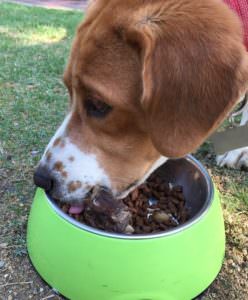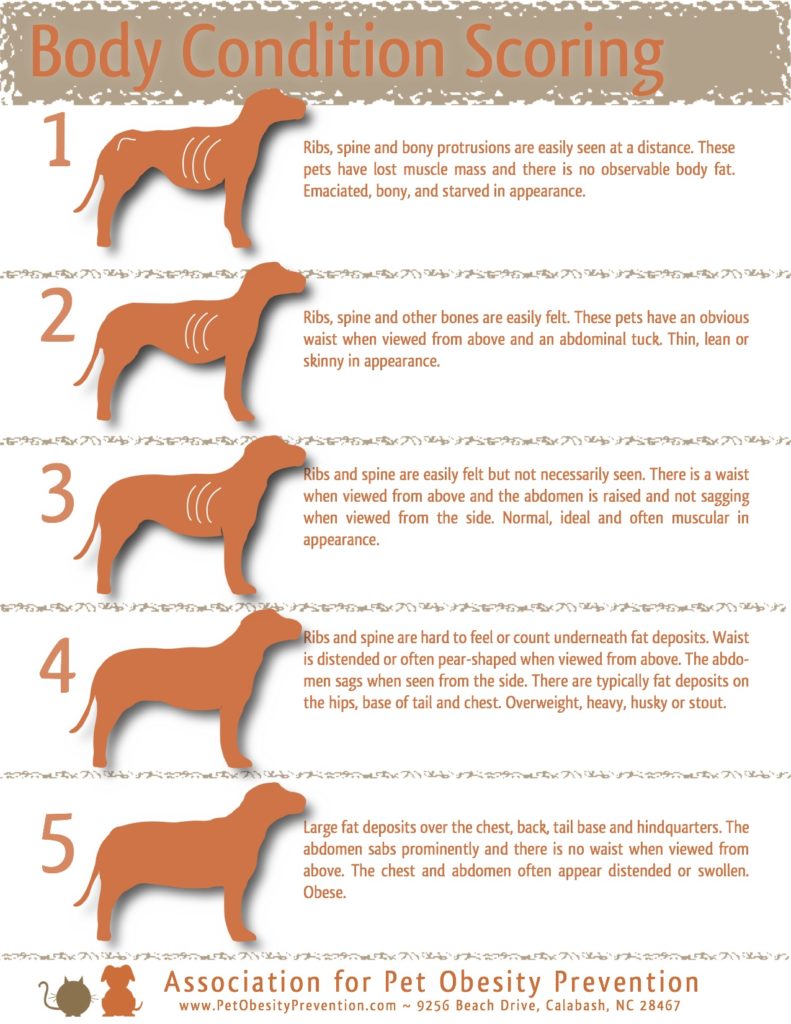
What if I told you that an easily preventable condition was going to steal years of your beloved dog’s life? Wouldn’t you do everything in your power to prevent or alleviate this condition?
Sadly, canine obesity is ravaging the health of our precious pets. According to The Association for Pet Obesity Prevention, an estimate 54% of dogs and 59% of cats in the USA are overweight. Their research goes on to show that obesity is more than just a cosmetic and appearance issue, it can take up to 2.5 years off their lifespan!
Without a doubt, canine obesity is an epidemic, and it’s time that we as pet parents did everything we can to prevent it and spread awareness. First and foremost, how do you know if your dog is affected?
How to Know if Your Dog is Overweight
According to the Association for Pet Obesity Prevention, here’s the best way for knowing if your dog is overweight:
A healthy weight is when:
1. The ribs are easily felt
2. Tucked abdomen visible – no sagging stomach
3. Waist visible when viewed from above
Your dog may be overweight if:
1. The ribs are difficult to feel under the fat
2. Sagging stomach – you can grab a handful of fat!
3. Broad, flat back
4. No waist visible
The Top 3 Strategies for Fighting and Preventing Canine Obesity
#1 – Make Exercise a Daily Habit, No Matter How Inconvenient
Not all dogs demand daily walks, but make an effort to get your pup moving in some way for at least 30 minutes a day. Each dog is unique and enjoys different kinds of activities, so there are myriads of ways to get your pup moving. A few of our favorites are:
- Toys: Balls or tug toys make great activities that help you bond with your pup while getting them moving.
- Hikes: Get your own heart rate up by hitting the trails with your dog.
- Bike Rides: Let your dog jog along side of you while you ride your bike. There are some great products like this hands free bike leash to make this both safe and effective.
- A Leisurely Walk: There’s nothing like a simple walk to get your blood flowing and offer mental and sensory stimulation for your dog.
- Swimming: Pool-time is a great form of low-impact exercise for dogs, especially pups already suffering from signs of arthritis.
Pro-tip: A handy tracker like the Whistle GPS Pet Tracker provides daily alerts letting you know when your dog is active, reminding you to meet your daily activity goal.
#2 – Do Not Overfeed Your Dog, and Limit Treats to Healthy Options
The most often repeated advice is often the best advice: limit your dog’s calorie intake! Remember that the amount of food you fed your dog when they were a 2 year old young adult may not be the appropriate amount now that they are an 8 year old senior. Talk to your vet to make sure you are feeding your dog an appropriate amount of food for their age. Also consider that the amount of food your dog food label instructs you to feed may not be accurate. After all, their goal is to sell you as much dog food as possible, not maintain your dog’s optimal weight.
Treats and table scraps also have a huge impact on your dog’s health and wellness. Make sure to avoid junk treats packed full of grains, carbs, sugar, and fat. This does not mean, however, that you cannot give your dog treats at all. We’re a huge fan of the raw freeze dried meat treat trend. Single ingredient, 100% meat treats are probably your best option, and best suit the diet your dog was designed to eat.
#3 – Take Care Of Your Dog’s Fragile Joints
Joint care is absolutely essential in your dog’s weight management plan. Obesity leads to strain on the joints, which then results in inflammation and leads to even less activity. This vicious cycle repeats itself, leading to a death spiral for your precious pup. Before you know it, your dog will barely rise to greet you anymore, and their fate is sealed.
Aside from diet and exercise, the best option for maintaining your dog’s healthy joint function is through glucosamine, MSM, and chondroitin. (in recent years, turmeric has also become a very popular and effective method of maintaining joint health and managing pain)
In general, larger dog breeds suffer from earlier and more extreme joint issues. The larger your breed of dog, the earlier you should consider supplementation with the above nutrients. These 9 breeds tend to suffer from the harshest joint problems, and these 18 breeds tend to suffer from genetically inherited hip dysplasia.
At iHeartDogs, we’re passionate about joint health and obesity prevention. We spent over 6 months developing what we believe to be the most advanced canine joint care product on the market, containing glucosamine, MSM, chondroitin, and turmeric. And like all of our products, each purchase provides food and care for dogs in rescues and shelters across the country.
But whether or not you try our product, the most important thing is that you take the time to develop an obesity prevention plan for your pup and stick to it! Our dog’s lives are short enough, we think they deserve the best we can give!
Learn More About Project Paws ™ Joint Care Products for Dogs
If your dog suffers from allergies and other sensitivities, you might also consider our hypoallergenic canine joint supplement.
These statements have not been evaluated by the Food and Drug Administration. This product is not intended to diagnose, treat, cure, or prevent any disease. The information on this website is not intended to replace a one-on-one relationship with a qualified health care professional.


